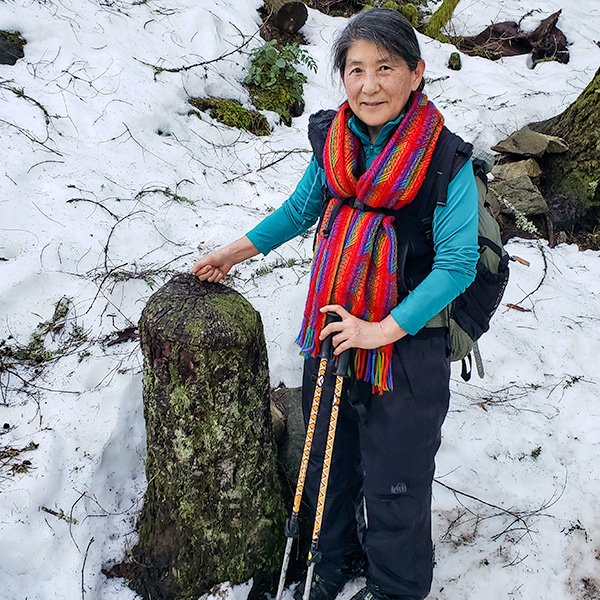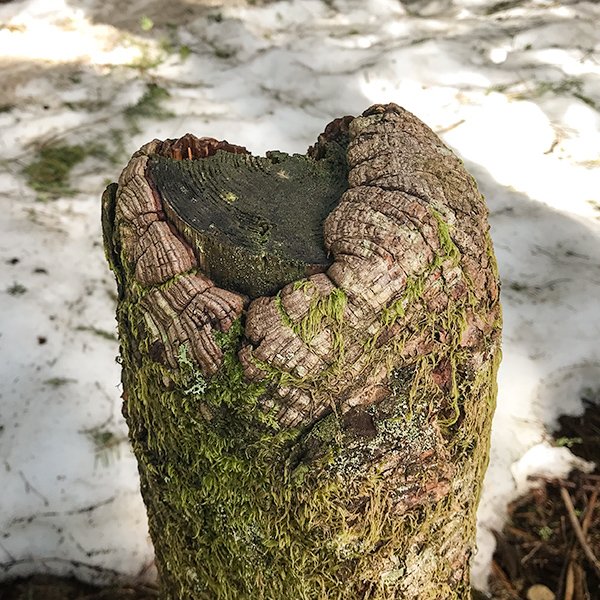Have you ever seen a stump that sealed itself? After the tree is cut down, the stump somehow keeps growing. Does this seem strange?
The photo above shows a living Douglas-fir stump. After the tree was felled, the stump grew bark-like tissue on top, sealing the cut surface — a process that takes decades. The bulging tissue eventually formed a cap on top of the stump. The stump can continue to grow in width, adding new growth rings for years after it was cut. *
Here’s another, in the photo below:
The photo below shows a Douglas-fir stump that has began to seal itself. It may never finish.
HOW do these stumps generate new growth if they have no leaves? (“Leaves” includes needles.) After all, leaves are where photosynthesis takes place. Photosynthesis is the process that converts solar energy to chemical energy in the form of sugar. Photosynthesis is the raison d’être of nearly all plants, including trees. Photosynthesis provides the energy that trees use to manufacture new tissue and grow.
So how did these stumps continue growing without leaves?
Answer: These stumps received energy underground, from other trees. The energy is in the form of sugars dissolved in water. There are two common pathways for underground energy transfer: Through (i) root grafts or (ii) mycorrhizae (fungal networks) among the roots of different trees. Through either of these two pathways, dissolved sugars can flow from tree to tree.
(i) ROOT GRAFTING occurs when two roots cross each other, then grow thick enough to press tightly together, and finally merge to the point that they share plumbing. Root grafting occurs among different roots of a single tree as well as between roots or two different but compatible trees. Trees that graft roots with other trees can benefit from each other by sharing underground resources. **
(ii) MYCORRHIZAE are underground networks of fungi that extend outward from trees’ root systems and permeate the soil. These networks vastly increase the surface area available to a tree for absorbing water and nutrients from the soil. Mycorrhizae can connect one tree to another, or one tree to many trees. For a good read about mycorrhizae, try the recent book by Suzanne Simard, Finding the Mother Tree (Knopf 2021).
WHICH of these two pathways — (i) root grafts or (ii) fungal networks — is primarily responsible for keeping some stumps alive long after the trees were felled? I do not know for sure. But the answer may be shaped by a different question:
WHAT causes the water and sugars to travel upward inside the stump, against gravity?
In a typical living tree, the upward tug of water starts at the top of a tree. By a process called transpiration, water evaporates outward through pores (stomata) in the leaves. Transpiration begins drawing water up. Water molecules then follow each other upward through the tree because water molecules cling to each other electrically.
So what happens in a stump, where there are no leaves and no transpiration?
Because a stump has no leaves, normal transpiration cannot be the “root cause” of upward motion inside a stump. Could the cause be evaporation from the top surface of the stump? Diffusion from cell to cell? Pressure from nearby trees? The processes inside living stumps are not well known.
One explanation for upward motion that seems plausible to me is this: The phloem (sap) in nearby trees flows downward inside those trees by gravity. This pressure pushes sap upward into a nearby stump that happens to be connected by root grafts. Roots are able to maintain this positive pressure inside their woody xylem cells. (It seems somewhat less likely to me that mycorrhizae, or fungal networks, could maintain this positive pressure.)
WHY do stumps seal themselves in this way? Why do nearby trees “waste” energy (i.e., dissolved sugars) on a seemingly dead stump? What advantage does this confer? The answer may lie in fending off pathogens. When trees are attached together through their roots, pathogens that gain entry through an open wound could travel from one tree to another. All trees that are connected to each other would benefit by capping the open wound, to prevent introduction of pathogens.
* There are records of living stumps that continued to add annual growth rings for many years after the tree was felled. See Living Stumps in the Sierra Nevada, Table 1 (1961).
** Trees with roots grafted together may also increase their mutual resistance to wind throw.


